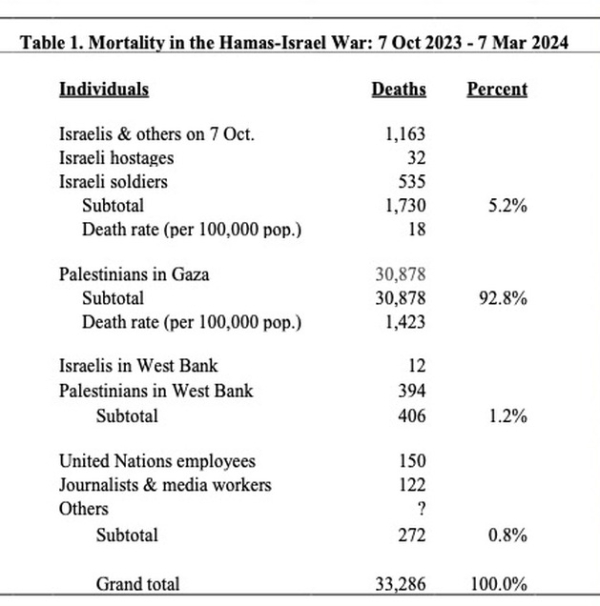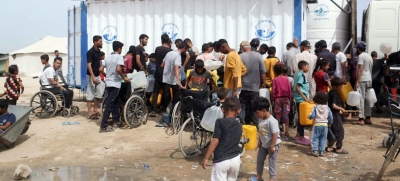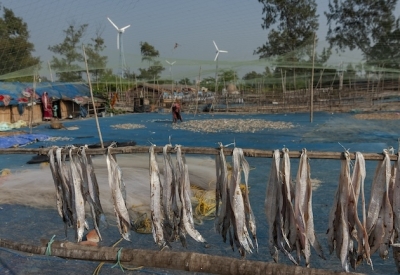PORTLAND, USA, Mar 12 (IPS) — Estimates of mortality in the Hamas-Israel war after five months of fighting indicate a Palestinian death rate 80 times greater than the Israeli death rate. In absolute terms, the number of Palestinian deaths is 18 times greater than the number of Israeli deaths.
The Palestinian death toll in the Gaza Strip is believed to be the highest such civilian casualty rate in the 21st century. Some have concluded that Israel’s bombing of Gaza is one of the most intense civilian punishment campaigns in history.
Even Israel’s major benefactor and chief ally, the United States, has criticized the bombing of Gaza. President Biden called Israel’s military action “over the top” and warned Israel that it was losing international support because of its “indiscriminate bombing” of Gaza. Secretary of State Blinken has also told Israel that ultimately there is no military solution to Hamas.
Although the numbers of deaths continue to be updated, current reported estimates provide an intelligible picture of the war’s lethal consequences on human life between 7 October 2023 and 7 March 2024, especially for the civilian population in Gaza (Table 1).
According to Israeli officials, the revised number of Israeli deaths resulting from the horrific attack by Hamas-led militants on 7 October 2023 is 1,163. Around 70 percent of the victims identified in the attack were civilians.
Those killed in Israel on October 7 also include foreigners and dual nationals. No less than 31 U.S. citizens, 39 French citizens and 34 Thai citizens were killed, according to country authorities. The Israeli military also said that 1,500 Hamas fighters were killed during the 7 October attack.
Israeli authorities reported that more than 240 individuals from more than 40 countries, including young children and the elderly, were taken hostage on 7 October and are believed to be held by Hamas in Gaza.
An estimated 32 hostages are reported to have subsequently died, 112 hostages have been freed with 70 percent being women and children and about half of the hostages remain in Gaza.
In addition to those deaths, no less than 535 Israeli soldiers have died since the ground invasion began with the vast majority killed on 7 October. Also, at least 12 Israeli deaths occurred in the West Bank and approximately 6,900 Israelis have been injured since 7 October.
In response to the 7 October Hamas attack, the death toll in Gaza from Israeli military operations according to Gaza’s health ministry, which has previously been described as trustworthy by WHO’s regional office, is at least 30,878 Palestinians.
As of 7 March 2024, that mortality figure represents 1.4 percent of the population or more than one in every 70 Palestinians in Gaza killed.
The total number of Palestinian deaths includes both fighters and civilians with approximately two-thirds of the deaths being women and children. Most recently, at least 104 Palestinians waiting to get food from humanitarian aid trucks were reported to be killed by Israeli troops, which the Israeli military denies saying most were killed in a crush or run over trying to escape.
Also, Hamas has reportedly said it has lost about 6,000 of its fighters while Israel has said it killed some 13,000 Hamas members.
The number of deaths in Gaza is likely to be even higher than being reported by Palestinian health officials. The war has brought about a humanitarian catastrophe for the Palestinians with an estimated 8,000 missing with many under the rubble of buildings and others hastily buried, no less than 72,402 injured, or about 10 times the number of injured Israelis, and vital humanitarian assistance limited by Israel’s blockade.
Several months ago, the Israeli military put a complete siege on Gaza, i.e., no electricity, no food, no water and no gas. Gaza’s residents are now facing a serious lack of food, drinking water and medicine and a sanitation crisis with high rates of infectious disease, at least 90 percent among children under five, with nearly no access to medical care. Aid groups have labeled Gaza as the most dangerous place in the world for children.
The Gaza population is suffering the world’s worst current hunger crisis, which has led to high levels of malnutrition, wasting, stunting and trauma reaching famine thresholds. WHO recently reported that no less than 10 children have starved to death in Gaza since the war began.
The World Food Programme warned of a “man-made” famine in Gaza with nowhere else in the world with this many people at risk of severe hunger. Refugees International also found in their research that Israel’s blocking of aid is creating apocalyptic conditions inside Gaza.
International aid agencies have concluded that if nothing is done soon, widespread famine is imminent, especially starvation among young children and infants, with more deaths of Palestinians in Gaza inevitable (Figure 1).
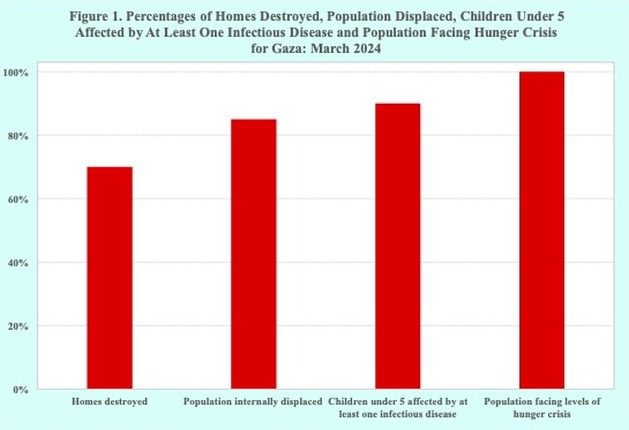
Approximately 70 percent of Gaza’s homes and half of its buildings, which include hospitals, schools, universities, mosques and churches, have been destroyed. The destruction and ruins in Gaza are said to resemble some of the most devastating campaigns in urban warfare in modern history.
According to US intelligence assessments, in the first two months of the war Israel dropped on Gaza more than 29,000 bombs, munitions and shells with 40-45 percent being unguided, including 900-kilogram (2,000 pound) “bunker-busters, and on areas that Israel designated safe for Palestinian civilians. Also, Israel’s heavy bombardment from air, land and sea included dropping 45,000 bombs weighing more than 65,000 tons on Gaza in a period of 89 days.
The war damaged or destroyed water, sanitation and health systems with approximately 1.9 million people, or about 85 percent of the total population of Gaza, displaced. Approximately half of Gaza’s population are sheltering in tent encampments in the southern city of Rafah, which Israel’s military plans to invade.
Besides Israeli and Palestinian deaths in Israel and Gaza since 7 October, others nearby have been killed. Violence in the West Bank has soared with at least 394 Palestinians reported to have been killed amid an increase in Israeli military raids and incursions. Also, 12 Israelis were killed in the West Bank during the five months following the 7 October attack.
In addition, more than 150 employees of the United Nations have been killed since the Israeli-Hamas war began. It is reported to be the deadliest conflict ever for the United Nations in such a short period of time. Moreover, no less than 122 journalists and media workers reporting on the war have been killed.
The high levels of civilian deaths are partly due to failed attempts to reach a cease-fire. Since the start of the Hamas-Israel war, the United Nations Security Council has considered three resolutions calling for an immediate cease-fire. The United States cast the sole “no” vote on each of those resolutions.
Regarding the adoption of the third resolution, the US said it could disrupt and jeopardize its ongoing negotiations to free Israeli hostages, secure a temporary cease-fire and increase desperately needed aid to Gaza. Recently, however, the US is pushing the Security Council to back an immediate cease-fire of roughly six-weeks in Gaza together with the release of all hostages.
The US administration faces serious criticisms internally for its vetoes as well as pressures to back a cease-fire, with some in Congress pushing to limit aid to Israel or impose strict conditions.
A national survey in February found two-thirds of US voters support calling for a permanent ceasefire and a de-escalation of violence in Gaza. The ongoing outrage over the continued support for Israel’s military offensive in Gaza poses a political problem for Biden in an election year.
Vice-President Harris recently bolstered the push for an immediate six-week cease-fire agreement, the release of hostages and increased humanitarian aid to Gaza facilitated by Israel with “no excuses”. She said the conditions in Gaza are inhumane with immense suffering with people starving and criticized Israel for not doing enough to ease a “humanitarian catastrophe”.
In contrast to the Security Council, the UN General Assembly adopted a resolution on 12 December 2023 demanding an immediate humanitarian ceasefire, the immediate and unconditional release of all hostages and ensuring humanitarian aid access. The resolution passed with a large majority of 153 in favor and 10 against, with 23 abstentions.
The global outcry over the breadth of death, devastation and displacement in Gaza has intensified. Growing numbers of countries, including Algeria, Brazil, Colombia, Indonesia, Ireland, Malaysia, Norway, Pakistan, and South Africa, have expressed serious concerns, outrage and condemnation regarding the scope and intensity of Israel’s military campaign and the humanitarian catastrophe created in Gaza.
The high mortality and humanitarian disaster have contributed to the growing isolation of Israel internationally and calls for an immediate humanitarian ceasefire.
Many government leaders have denounced the high number of Palestinian civilian deaths in Gaza. Also, more than 800 officials in the US, the UK and European Union signed a public letter of dissent against their governments’ support of Israel in its war campaign in Gaza.
South Africa appealed to the International Court of Justice, criticizing Israel for committing and failing to prevent genocidal acts. South Africa has also asked the court to issue emergency orders for Israel to stop the “genocidal starvation” of the Palestinian people.
Norway has also condemned Israel’s actions as contravening international law and breaching the principle of self-defense. Brazil’s President Lula da Silva accused Israel of committing genocide against Palestinians in Gaza.
Given Israel’s total population of approximately 9.8 million, the Israeli deaths on 7 October and in the Hamas-Israel war up to 7 March 2024 represent about 0.018 percent of its population, or 18 deaths per 100,000 population.
With an estimated total population of approximately 2.2 million in Gaza, the Palestinian deaths from the Hamas-Israel war up to 7 March 2024 represents about 1.423 percent of its population, or 1,423 deaths per 100,000 population, which is 80 times greater than the Israeli death rate.
When the Palestinian death rate of Gaza is applied to the population of Israel, the resulting hypothetical mortality would be a staggering 139,378 Israeli deaths, which is about 80 times greater than Israel’s actual number. Conversely, applying the Israeli death rate to the population of Gaza would yield a low of 383 Palestinian deaths, or 1.2 percent of Gaza’s actual number (Figure 2).
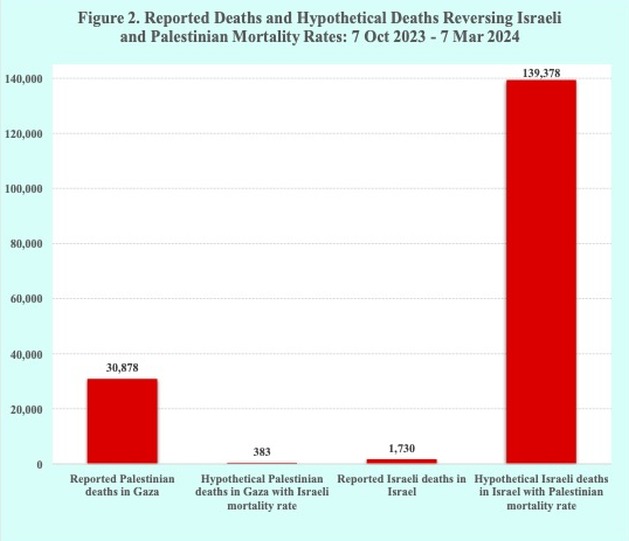
If those hypothetical deaths of 139,378 Israelis and 383 Palestinians had actually occurred, a relevant question to consider is whether the international community with the United States taking the lead would have adopted a ceasefire early on in the war.
The deaths, injuries, displacements and suffering resulting from the Hamas-Israel war after five months continues to be updated with new information from authorities, international organizations, hospitals, mortuaries and families. Additional demographic analyses, studies and surveys will be needed to provide a comprehensive assessment of the war’s mortality and misery.
During this century-long conflict that began with the British Mandate for Palestine and centers principally on religion and demographics, large numbers of deaths and population displacements have occurred. To resolve the conflict and halt the killing and injuries of Israelis, Palestinians and others, various solutions have been proposed.
The two-state solution is the preferred option of many countries, including the United States, other allies of Israel and the UN Security Council, with some countries considering recognizing a Palestinian state. However, many scholars consider the two-state solution to be a mirage or no longer possible.
Israel has expressed its opposition to the creation of a Palestinian state. The government has approved the building of thousands new homes in Israeli settlements in the West Bank. Also, some are calling to rebuild them in an Israeli controlled Gaza, encouraging Palestinians to leave and promoting plans to occupy both the West Bank and Gaza indefinitely.
Given the salient demographics on the ground, i.e., the de facto one-state reality, some anticipate the emergence of the one-state solution. In such an outcome, the Jewish residents would constitute approximately 47 percent of the total population, a fundamental change from the Jewish majority of 74 percent in Israel today. The one-state solution would also need to consider civil rights, justice and equality before the law for all its residents, a fundamental goal of democracies.
Finally, it seems evident, unfortunately, that without a peace resolution to the protracted Israeli-Palestinian conflict, the loss of lives, injuries, displacements and misery will likely continue unabated.
Joseph Chamie is a consulting demographer, a former director of the United Nations Population Division and author of numerous publications on population issues, including his recent book, "Population Levels, Trends, and Differentials".

